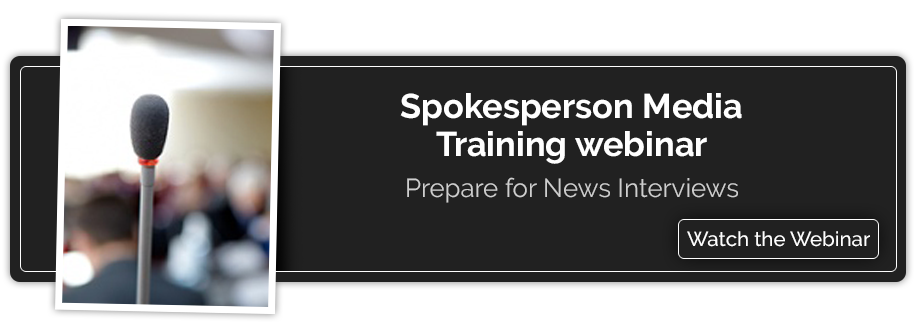Make sure your spokesperson is armed with these media training tips before they take on the mic.
 Going on the record with a reporter can be intimidating. Are there any “gotcha” questions, and how should you answer them? Can you ask for interview questions ahead of time? How do you discuss something you don’t want to appear in print?
Going on the record with a reporter can be intimidating. Are there any “gotcha” questions, and how should you answer them? Can you ask for interview questions ahead of time? How do you discuss something you don’t want to appear in print?
Even the most seasoned spokesperson is constantly learning how to approach the media landscape to avoid saying the wrong thing and going viral.
Audio: Listen to this article.
Let’s dive into some media training basics so your spokesperson can take center stage.
Before the Interview
First and foremost, before any media interview, confirm whether the conversation is on the record, on background, or off the record, and ask the reporter to break down the specifics of what that means in their book. Some reporters can have varying definitions of how that looks — specifically, what is fair game to publish.
If it’s on the record, know what information you can share publicly and what information is still considered confidential. You’d hate to break the news early about a new CEO, product launch, or partnership and lose the opportunity to share the news on your terms.
Overall, it’s good practice to jot down a few anticipated questions ahead of the interview and appropriate answers for each to better prepare. Another good exercise before the interview is to write out approximately three talking points you want to emphasize during the interview so you can better control the narrative. If the opportunity doesn’t naturally arise in the line of questioning, reporters may ask, “Is there anything I missed?” at the end of the interview. You can use that opportunity to address those key messages.
Don’t forget to do your due diligence on the reporter and publication ahead of time. Research the reporter and their beat, read a few of their recent articles to get a sense of their storytelling, and assess the tone of those stories to determine what questions they will likely ask.
Check their social channels to understand where they’re focused lately. Certain publications can have overarching reporting themes as well. Do they write more fluff pieces, or do most stories have negative clickbait-style headlines? It’s always better to go into an interview fully prepared to eliminate surprises and share your message with complete clarity.
During the Interview
Once you’re speaking with the reporter, answer as though anything you say could appear as a quote. Here are a few tips to keep top of mind to achieve the best sound bites:
- Speak in headlines. Offer a conclusion first, briefly and directly, followed by supporting facts or proof points.
- Don’t over-answer. Short answers are better than long answers.
- Don’t repeat a reporter’s negative statements. Frame your reply as a positive statement.
- Speak clearly. Avoid jargon that could confuse the less-informed reader or listener. Or, briefly explain industry terms if it’s crucial to your point.
- Don’t know the answer? Don’t fake it. If appropriate, assure the reporter you will follow up with needed facts or offer another source.
Always remember the interview isn’t over until you hang up the phone. If it seems like the interview has ended and the two of you are speaking more casually, recognize that until you have gone off the record, anything you say could still be fair game. Be sure to make that clarification if the conversation starts to open up.
After the Interview
Once the interview has ended, reach out to the reporter and share any follow-up materials that provide additional information on topics you touched on. Offering graphics, data, images, logos, and other materials to enhance your story will be appreciated.
Suppose there is anything you realize you miscommunicated. In that case, you can also follow up with factual clarifications to avoid spreading misinformation or asking for a correction after the story has gone live.
Once the story is out, make sure you’re sharing it on your social channels, website, and newsletters, as well as internally with employees and externally with stakeholders. This is a great opportunity to drive awareness around your organization.
Ready to move on to lesson number two? Learn more media relations best practices, and book a one-on-one consultation with us to set up a personalized media training session.
Photo by Terje Sollie
Topics: spokesperson training, earned media, news media, public speaking



Comment on This Article